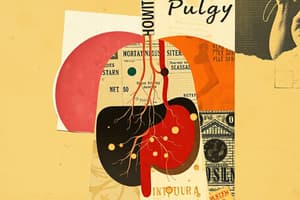Podcast
Questions and Answers
What is homeostasis?
What is homeostasis?
- The process by which an organism grows and develops
- The process by which an organism adapts to external changes
- The process by which an organism's body fluids are regulated
- The process by which a fairly constant internal environment is maintained in an organism (correct)
What are the components of the internal environment of an organism?
What are the components of the internal environment of an organism?
- Nerves, hormones, and enzymes
- Skin, hair, and nails
- Blood, lymph, and tissue fluid (correct)
- Muscles, bones, and organs
What are the conditions that an organism must be able to adjust to for efficient cell function and healthy growth?
What are the conditions that an organism must be able to adjust to for efficient cell function and healthy growth?
- Temperature, PH, osmotic pressure, concentrations of dissolved substances, and mineral ions (correct)
- Light intensity, humidity, and atmospheric pressure
- Gravity, magnetic fields, and radiation levels
- Sound frequency, air quality, and electromagnetic fields
What are the components of homeostatic processes?
What are the components of homeostatic processes?
How is osmoregulation ensured in unicellular organisms?
How is osmoregulation ensured in unicellular organisms?
Flashcards are hidden until you start studying
Study Notes
Homeostasis and Internal Environment
- Homeostasis is the ability of an organism to maintain a stable internal environment despite changes in the external environment.
- The internal environment of an organism consists of the fluid-filled space between cells, including blood plasma, lymph, and interstitial fluid.
Conditions for Efficient Cell Function and Healthy Growth
- An organism must be able to adjust to changes in temperature, pH, oxygen levels, nutrient availability, and waste removal to maintain efficient cell function and healthy growth.
Components of Homeostatic Processes
- Homeostatic processes involve three components: receptors, effectors, and negative feedback loops.
- Receptors detect changes in the internal environment and send signals to the brain or other control centers.
- Effectors, such as muscles or glands, respond to the signals and make changes to restore balance.
- Negative feedback loops regulate the response to maintain homeostasis.
Osmoregulation in Unicellular Organisms
- In unicellular organisms, osmoregulation is ensured through the cell membrane, which regulates the movement of water and ions to maintain proper osmotic balance.
Studying That Suits You
Use AI to generate personalized quizzes and flashcards to suit your learning preferences.



